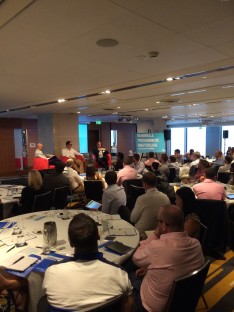Telstra aims for 80 per cent digital spend through programmatic by June
 Telstra has lifted the lid on its programmatic client trading desk claiming it has developed a major competitive advantage in the digital marketing space, with 65 per cent of its spend now directed through it.
Telstra has lifted the lid on its programmatic client trading desk claiming it has developed a major competitive advantage in the digital marketing space, with 65 per cent of its spend now directed through it.
Speaking today at the Mumbrella Programmatic Trading Masterclass Telstra’s GM of digital marketing Harry Lowes and Dan Robins, head of performance at media agency OMD, described how two years into its program the telco already had 65 per cent of its digital spend going through the programmatic trading desk, and how they had brought in staff from creative agency DDB to cut lead times.
“Our ambition is to have 80 percent of our media digital dollars go through some sort of programmatic capacity by the end of the financial year. Which is a big jump from where we are now,” said Lowes.
At its simplest programmatic trading allows the telco to automate media buying, using a computerised system to bid on adspace.
Lowes told the audience that his ambition for the program was to become the first port of call when there was a problem with sales.
He added: “We want a seat at table. I want to be the first person called when there is a problem anywhere in the organization with sales performance. And we will have a solution because we are the fastest to market.
“That’s the ambition that underlies why we are pushing in this space.”
While a move to programmatic trading is seen as the future for many media agencies, allowing them to make greater margins and cut staff overheads, OMD’s Robins explained the innovative program had not seen a drop in staff but rather a dramatic expansion in his team from two to 14.
At the start they also brought in staff from creative agency DDB to work directly with the OMD team and help ensure that work flowed quickly and gave Telstra a competitive advantage it marketing speed.
“At the beginning of the year we decided to make the most of the opportunity and integrate the DDB creative team into the OMD media team and have them in at OMD three days a week,” said Robins.
“Rather than have the typical creative to media back and forwards over email and meetings etc all of that time can be cut out and you can put your head over the desk so that guys can be making those decisions almost instantly.”
Amid a flurry of new programmatic entrants in the space Robins also spoke about how they selected partners to work with, telling the audience in display they work with the likes of Adobe and Double Click, while in video they worked with the companies including Adapt.TV and TubeMogul.
But OMD’s Robins also indicated he had an open door policy to partners telling the audience: “We’ve selected partners for the here and now, but if something else comes along then we will test it and see how it goes. We are pretty much working with all of them it is not a closed door by any stretch.”
He also talked about the Omnicom group’s programmatic program Accuen, which has been developed into a bespoke model to service Telstra’s needs.
“Why bespoke? Scale is the short answer to that and also transparency,” he said. “The model itself is transparent in its own right and the dark days of arbitrage and the rest are behind us.
“It’s not so much the transparency around the actual buys, it’s around having a team of people working 100 percent for the brand. Their sole focus is purely Telstra and they know the brand inside and out.”
Lowes told the audience that programmatic marketing would redefine much of the marketing space in the coming years.
“I can see that with marketing strategies the cycling times (to get work done) will collapse. We are going to be trading dollars based on opportunity and the marketing mix,” said Lowes.
“I don’t think other media will be available through this capability yet, but it will start to get there and on the back of that the relationships between publishers and marketers will be very different.”
He added that data would increasingly be at the centre of these transactions, adding: “There will be relationships that exist where there is either the trading of data or a symbiotic relationship between two business where they are able to leverage their audience better.
“Content makers will also be able to have a much more influential conversation with marketers. I think it is going to be very different.”
Nic Christensen
(*Declaration TubeMogul were a sponsor of the event.)



 Linkedin
Linkedin
As a creative I have nothing but respect for Harry. He’s a really smart guy who totally gets the digital space. He also loves and values great ideas. He gives me faith in the new breed of marketers coming through.
User ID not verified.